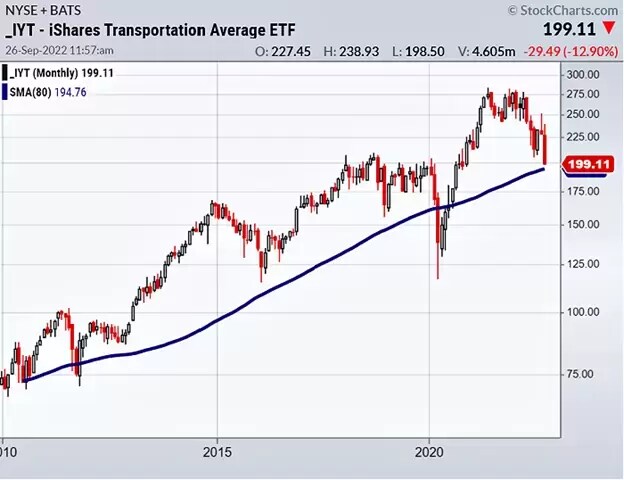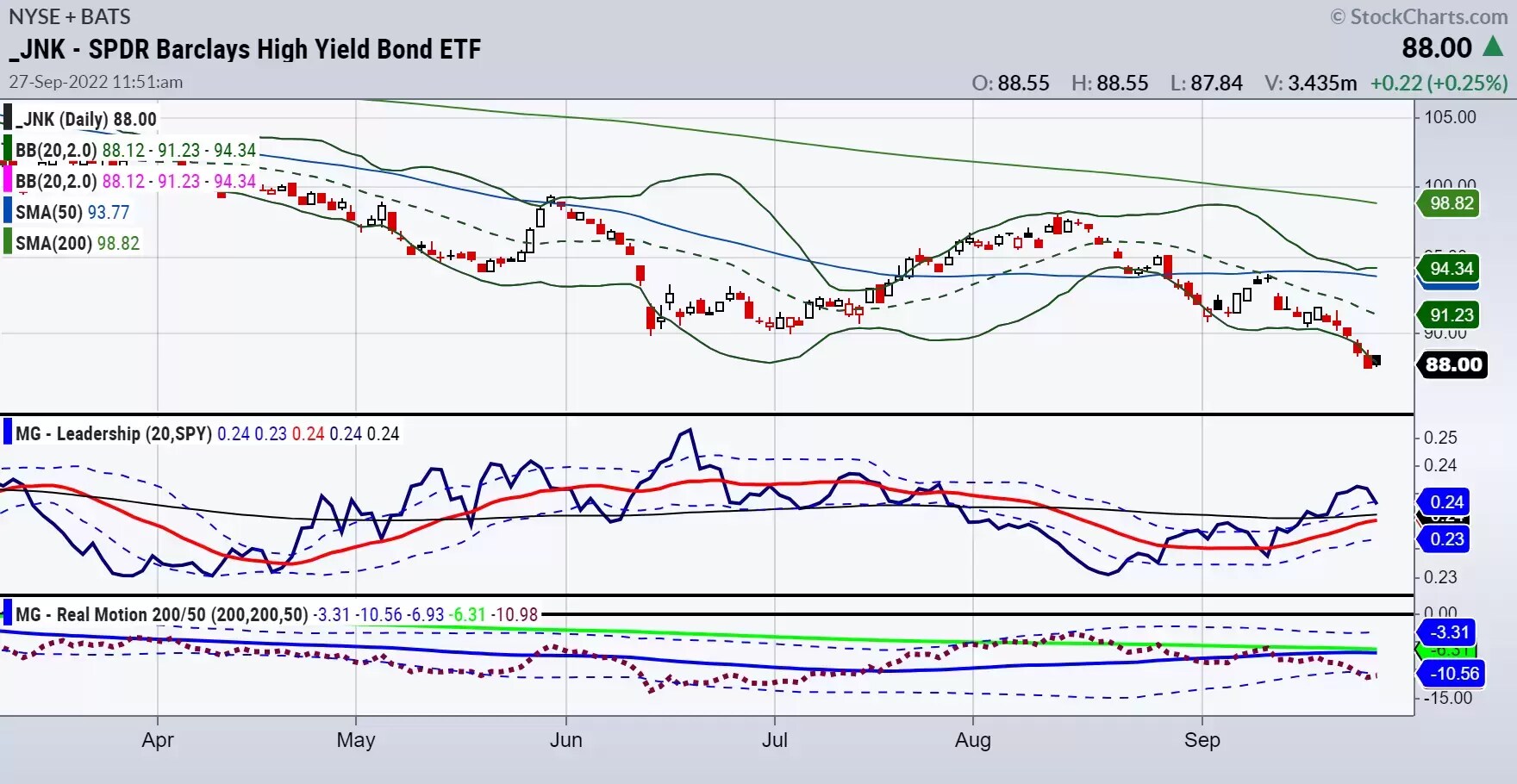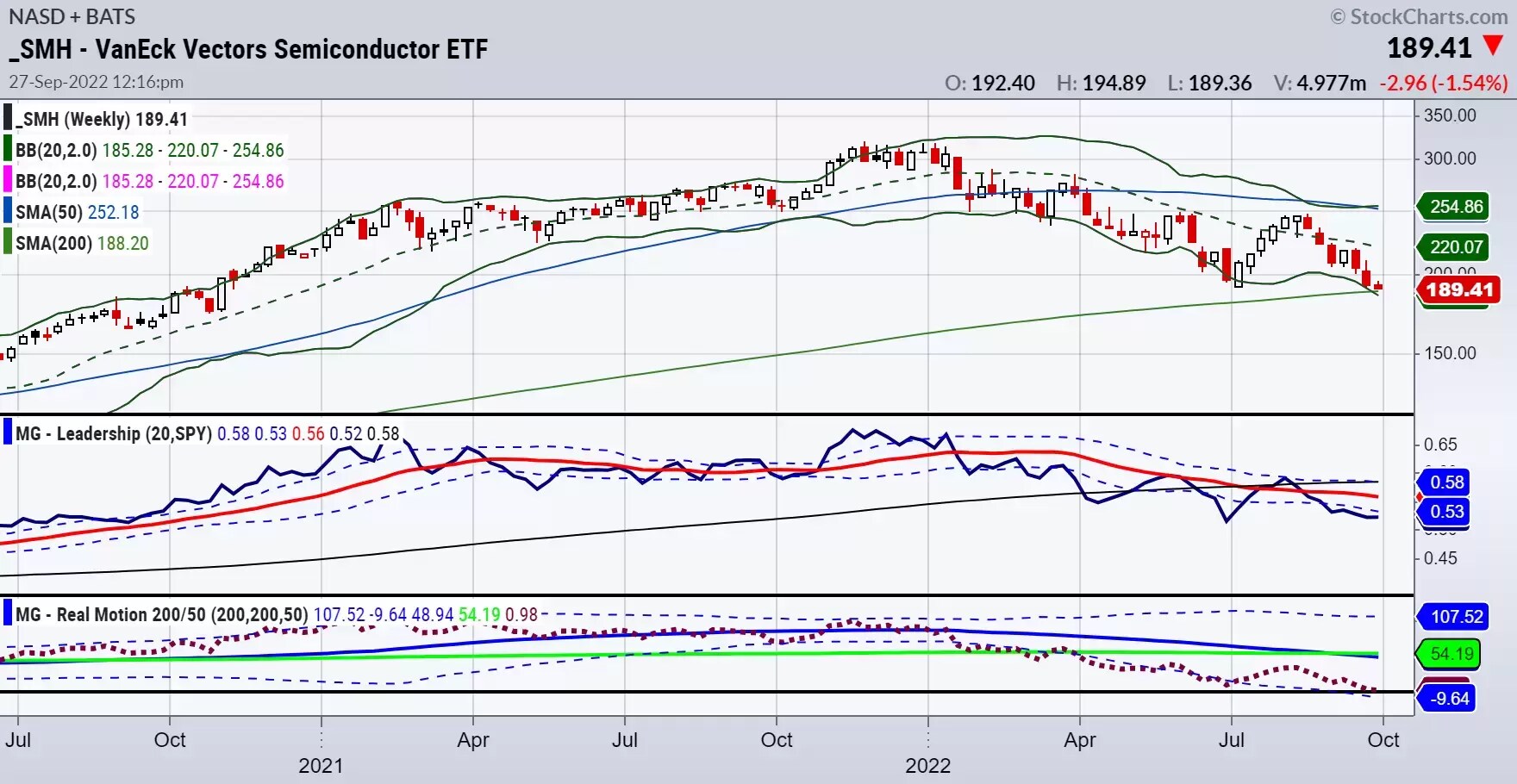
With three major US indices – the S&P 500, Nasdaq 100 and Russell 2000 – hovering around the June 2022 lows, dip-buyers are watching and waiting.
The long-term chart of the iShares US Transportation ETF (IYT), below, is another indicator to keep an eye on. The dark blue line shows the 80-month moving average, measuring a six- to seven-year business cycle. IYT’s price is testing that average.

Besides IYT, two other members of my Economic Modern Family are also testing their 80-month moving averages – Granddad Russell 2000 (IWM) and Grandma Retail (XRT). Together with IYT, these three funds are arguably among the best indicators of the internal workings of the US economy.
The small-cap Russell 2000 index represents manufacturing, or the supply side of the US economy. Meanwhile, XRT and IYT represent the demand side, or how goods are moving.
Transportation at a crossroads
The transport fund IYT has remained above that dark blue line – the 80-month moving average – for most of the past 11 years, the exceptions being a brief blip in 2011 when the government came within a whisker of a temporary shutdown over a funding shortfall, and another dip during the coronavirus pandemic. At time of writing, the blue line was at about 195.
The Russell 2000 fund IWM and retail’s XRT are also just about holding their monthly moving averages.
So, is IYT likely to hold and rally back towards 220, or might it fail 195 and trigger a further sell-off? Watch this space.
Junk bonds as important as ever
Another indicator to watch is the SPDR Bloomberg Barclays High Yield Bond ETF (JNK), which tracks high-yield corporate bonds, also known as junk bonds.
JNK failed its 80-month moving average back in November 2021, giving an early signal that bond traders’ appetite for risk was fading, even as the Nasdaq and S&P 500 were trading at record highs.
As the chart below shows, JNK dropped to a fresh low this week. We are looking at an 84.00 target. However, it is outperforming the SPY on the Leadership indicator. If JNK holds and trades back above 90.00, we would look to pivot from our current position, directing some of our cash back into riskier assets.

Semiconductors cling to moving average
The VanEck Semiconductor ETF (SMH) is extremely interest-rate sensitive. The sector peaked right after junk bonds failed in November 2021. The high print for SMH that month was 318.82.
The weekly chart below shows the price sitting right on the 200-week moving average, indicated by a light green line. The June low was 189.94. This week, SMH broke below that level and appears to be hanging on to the key weekly moving average for dear life. If that level can hold, perhaps a severe sell-off of bonds with short-term and intermediate-term yields can be avoided.

SMH remains far above its 80-month moving average, unlike the Russell 2000 (IWM) transportation (IYT) and retail (XRT), which are testing the lows of a long, positive business cycle.
If SMH breaks below its 200-week moving average, IWM, IYT and XRT may break their 80-month moving averages.
At that point, SMH may head down towards its 80-month moving average around 145, roughly $45 below its current price.
When to put cash back to work?
To sum up, the following scenario might tempt us to consider reinvesting our cash:
1. If transportation (IYT) holds 195 and trades with some gusto back above 205, indicating that the demand side is holding up.
2. If junk bonds (JNK) hold 84.00-85.00 and make their way convincingly back over 90.00, indicating a strengthening risk appetite.
3. If semiconductors (SMH) find some footing at current levels of 189-190, and rally back towards 195 or, even better, over 200, suggesting that interest rates could be topping out.
Until then, cash (USD) remains king.
Mish’s ETF support and resistance levels
S&P 500 (SPY) Testing the previous low; support at 362, resistance at 370
Russell 2000 (IWM) Broke the June low of 165.18; support at 162, resistance at 170
Dow (DIA) Broke the June low; support at 289, resistance at 298
Nasdaq (QQQ) Testing the June low; support at 269, resistance at 280
Regional banks (KRE) support at 57, resistance at 61
Semiconductors (SMH) support at 187, resistance at 194
Transportation (IYT) support at 196, resistance at 204
Biotechnology (IBB) support at 112, resistance at 118
Retail (XRT) support at 55, resistance at 60
Mish Schneider is MarketGauge’s director of trading education and research. Read more of MarketGauge’s market analysis here, and subscribe to their YouTube channel here. Mish Schneider's and MarketGauge's views and findings are their own, and should not be relied upon as the basis of a trading or investment decision. Pricing is indicative. Past performance is not a reliable indicator of future results.
Disclaimer: CMC Markets is an execution-only service provider. The material (whether or not it states any opinions) is for general information purposes only, and does not take into account your personal circumstances or objectives. Nothing in this material is (or should be considered to be) financial, investment or other advice on which reliance should be placed. No opinion given in the material constitutes a recommendation by CMC Markets or the author that any particular investment, security, transaction or investment strategy is suitable for any specific person. The material has not been prepared in accordance with legal requirements designed to promote the independence of investment research. Although we are not specifically prevented from dealing before providing this material, we do not seek to take advantage of the material prior to its dissemination.






















